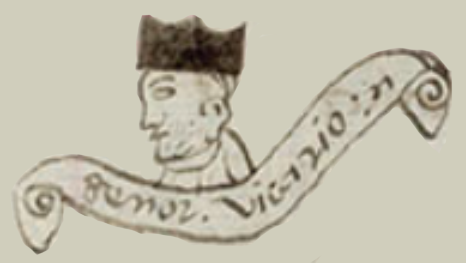vicario (CST28)
This painting of the simplex glyph for the term vicario (a loanword from Spanish meaning that entered Nahuatl and meant vicar) shows the head, neck, and shoulder of a man in profile, facing toward the viewer’s left. He wears a robe with a cowl neck and a black three-pointed hat. Underneath this glyph and forming a part of it is a banderole with the words in Spanish “señor vicariocin.” The companion text calls this man “totacin” (i.e., totatzin, our father, i.e. the priest).
Stephanie Wood
For more on the Codex Sierra, see Kevin Terraciano’s study (2021), especially p. 152. This incorporation of alphabetic writing into the pictorial writing occurs many times in this manuscript. Terraciano (p. 49) calls the use of banderoles “a medieval heraldic convention in Europe and a rare example of alphabetic writing that intrudes on the pictorial side of the text.” The number of priests small in this digital collection as of October 2024, but the contextualizing image for amoxtli on image 19 of the Mexicanus is worth a view. See below.
Stephanie Wood
1550–1564
Jeff Haskett-Wood
vicarious, iglesias, sombreros, escrituras

vicario, vicar (a loanword from Spanish that entered Nahuatl), https://nahuatl.wired-humanities.org/content/vicario
vicario
Stephanie Wood
Códice Sierra-Texupan, plate 28, page dated 1559. Origin: Santa Catalina Texupan, Mixteca Alta, State of Oaxaca. Kevin Terraciano has published an outstanding study of this manuscript (Codex Sierra, 2021), and in his book he refers to alphabetic and “pictorial” writing, not hieroglyphic writing. We are still counting some of the imagery from this source as hieroglyphic writing, but we are also including examples of “iconography” where the images verge on European style illustrations or scenes showing activities. We have this iconography category so that such images can be fruitfully compared with hieroglyphs. Hieroglyphic writing was evolving as a result of the influence of European illustrations, and even alphabetic writing impacted it.
https://bidilaf.buap.mx/objeto.xql?id=48281&busqueda=Texupan&action=search
The Biblioteca Digital Lafragua of the Biblioteca Histórica José María Lafragua in Puebla, Mexico, publishes this Códice Sierra-Texupan, 1550–1564 (62pp., 30.7 x 21.8 cm.), referring to it as being in the “Public Domain.” This image is published here under a Creative Commons license, asking that you cite the Biblioteca Digital Lafragua and this Visual Lexicon of Aztec Hieroglyphs.


